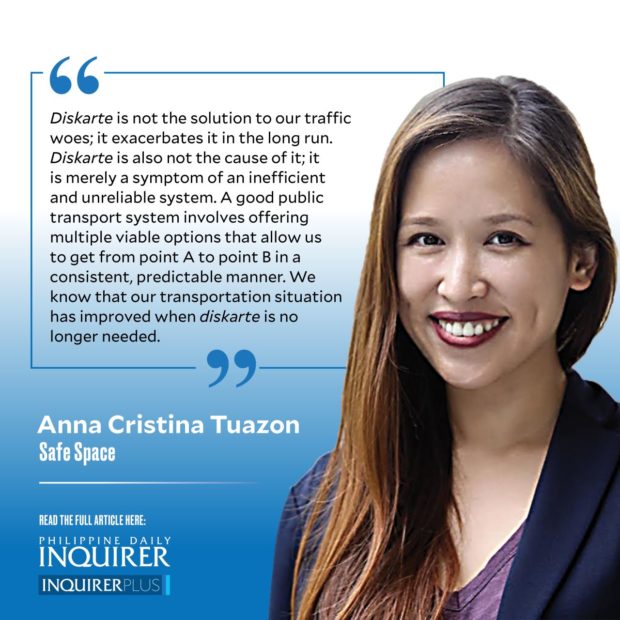Walk or wait
Filipino Christmas wouldn’t be complete without queso de bola, “Pinoy” spaghetti (with hopefully more than 1/8 kilo of giniling), Jose Mari Chan’s “Christmas in Our Hearts,” and holiday traffic. We had a temporary respite from carmageddon when most work and schools were still online, but, alas, traffic is back with a vengeance. What used to be a 20-minute drive to work pre-pandemic has become an hourlong ordeal. My brother claimed that his own drive home from Quezon City to Pasig City during rush hour would cost him two and a half hours, making him consider the long lines at the MRT instead. Grab has been extremely hard to book nowadays, not to mention its high cost. I often walk past crowds of commuters waiting tiredly for available jeepneys and buses. No mode of transportation in Metro Manila can objectively be described as convenient, despite Sen. Mark Villar’s bold prediction last year that “by 2022, every city in Manila will be 20-30 minutes away.”
Even more traditional than traffic itself is complaining about it. Filipinos have complained about traffic for years, if not decades. While traffic is a political issue in that it will require a coordinated government response to solve it, it has never been partisan, as all sides are criticized for failing to address it properly. However, the conversation around this issue has taken on a strange color. Instead of acknowledging the systemic issue of transportation, people have accused complainers of simply lacking diskarte. (My fellow columnist Inez Ponce de Leon already led a meaningful discussion on diskarte last week, which highlighted how focusing on individual diskarte is a form of oppression.)
Article continues after this advertisementIn response to Atom Araullo’s tweet decrying a broken transport system when he was stuck at the airport, one person said that if he had diskarte, he would have realized he had two options: walk or wait. I would venture to say that such options are utterly devoid of true diskarte. Diskarte, by definition, requires creative flexibility in order to take personal advantage of an undesirable situation. An example of this is knowing the best spot to flag down a bus or jeepney that minimizes competition from other passengers, while still having the best chance of available seats. Driving diskarte means knowing the best routes or times to avoid traffic.
Diskarte is never about passively accepting the status quo. Walking or waiting is not a diskarte move, but an unimaginative—and highly inefficient—one. I am a passionate pedestrian; I would walk everywhere if I could. (Every time I pass through the newly built Kalayaan Bridge that connects Pasig City to BGC, I can’t help but get frustrated that they didn’t design it with a continuous pedestrian walk.) But even I wouldn’t dare to walk, with luggage in tow, all the way from the Ninoy Aquino International Airport to my house. Sidewalks are scattered and segmented, if there are even any, and protected crosswalks are few and far between. As for waiting … well, it’s not exactly a transport option, is it?
Recently, one of my balikbayan relatives wondered out loud why people drive the way they do in Manila. My answer: diskarte. This is what a road filled with diskarte motorists, cyclists, and pedestrians look like. Our roads and transport have trained us too well in using diskarte that it created a world where no one gives way and one would cut in whenever one could. There are explicit driving rules, and then there are the hidden wisdom of Manila drivers. For example, if you use a turn signal before you switch lanes, it will just cause other cars to speed up to prevent you from doing so, and so we learn to swerve. If you allow sufficient space between you and the car in front of you, another car will only use that to cut in, and so we learn to tailgate.
Article continues after this advertisementA road full of diskarte drivers creates chaos and gridlocks. Reports of ride-hailing app drivers turning off their phones to game the system to force passengers to cancel rides (and thereby avoiding the cancellation penalty if the drivers do it themselves) cause ride shortages and price hikes. Jeepneys and buses who catch passengers outside of designated stops may get to fill their passenger quota sooner, but at the expense of passengers who follow the rules.
Diskarte is not the solution to our traffic woes; it exacerbates it in the long run. Diskarte is also not the cause of it; it is merely a symptom of an inefficient and unreliable system. A good public transport system involves offering multiple viable options that allow us to get from point A to point B in a consistent, predictable manner. We know that our transportation situation has improved when diskarte is no longer needed.
——————
















